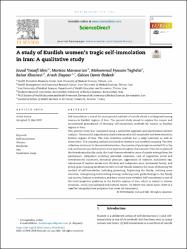| dc.contributor.author | Iebni, Javad Yoosefi | |
| dc.contributor.author | Mansourian, Morteza | |
| dc.contributor.author | Taghdisi, Mohammad Hossain | |
| dc.contributor.author | Khosravi, Bahar | |
| dc.contributor.author | Ziapour, Arash | |
| dc.contributor.author | Ozdenk, Gulcan Demir | |
| dc.date.accessioned | 2019-11-24T20:59:54Z | |
| dc.date.available | 2019-11-24T20:59:54Z | |
| dc.date.issued | 2019 | |
| dc.identifier.issn | 0305-4179 | |
| dc.identifier.issn | 1879-1409 | |
| dc.identifier.uri | https://dx.doi.org/10.1016/j.burns.2019.05.012 | |
| dc.identifier.uri | https://hdl.handle.net/20.500.12513/3340 | |
| dc.description | WOS: 000489028200025 | en_US |
| dc.description | PubMed ID: 31202529 | en_US |
| dc.description.abstract | Self-immolation is one of the most painful methods of suicide which is widespread among women in Kurdish regions of Iran. The present study aimed to explore the causes and sociocultural groundwork of choosing self-immolation methods by women in Kurdish regions of Iran. This present study was conducted using a qualitative approach and conventional content analysis. The research population included women who self-immolated and were rescued in Kurdish regions of Iran. The data collection method was a deep interview as well as observation. The sampling method was based on objective and snowball sampling. The data collection continued to theoretical saturation, the number of participants reached 25 in the end, and Lincoln and Guba criteria were used to strengthen the research. From the analysis of the data obtained in this study, the 8 sub-themes related to cause of suicide attempt from the participants' viewpoints including unbridled coherence, lack of supportive social and environmental structures, economic pressure, aggravation of violence, humiliated ego, dominance of modern values over the local and indigenous ones, incoherent family, and giving up on changing conditions as well as 6 sub themes based on the cause of choosing the method of self-immolation including protesting, frightening the family, catching more attention, championing and showing courage, inducing more guilty feelings in the family and society, fashion or imitation, and easy access were revealed. Self-immolation is one of the most important problems in the Kurdish regions of Iran, which is rooted in various economic, social, psychological and cultural causes. To reduce this social harm, there is a need for comprehensive programs that cover all dimensions. (C) 2019 Elsevier Ltd and ISBI. All rights reserved. | en_US |
| dc.description.sponsorship | School of Public Health, Iran University of Medical Sciences | en_US |
| dc.description.sponsorship | This study was financially supported by the School of Public Health, Iran University of Medical Sciences. | en_US |
| dc.language.iso | eng | en_US |
| dc.publisher | ELSEVIER SCI LTD | en_US |
| dc.relation.isversionof | 10.1016/j.burns.2019.05.012 | en_US |
| dc.rights | info:eu-repo/semantics/closedAccess | en_US |
| dc.subject | Self-immolation | en_US |
| dc.subject | Women | en_US |
| dc.subject | Kurdistan | en_US |
| dc.subject | Iran | en_US |
| dc.subject | Qualitative study | en_US |
| dc.title | A study of Kurdish women's tragic self-immolation in Iran: A qualitative study | en_US |
| dc.type | article | en_US |
| dc.relation.journal | BURNS | en_US |
| dc.contributor.department | Kırşehir Ahi Evran Üniversitesi, Sağlık Hizmetleri Meslek Yüksekokulu, Tıbbi Hizmetler ve Teknikler Bölümü | en_US |
| dc.identifier.volume | 45 | en_US |
| dc.identifier.issue | 7 | en_US |
| dc.identifier.startpage | 1715 | en_US |
| dc.identifier.endpage | 1722 | en_US |
| dc.relation.publicationcategory | Makale - Uluslararası Hakemli Dergi - Kurum Öğretim Elemanı | en_US |


















